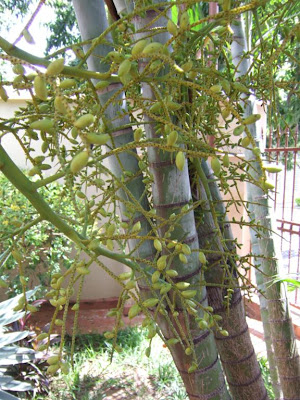Since we last posted here we moved. In our new backyard there are some fruit trees. One day, July 15, 2009, we had an incredible event in our yard.
Judy came running into the house to tell me the Jatai Bees were swarming.
Here is the first pic. There were hundreds of tiny bees flying around their nest.
This is the entrance to the nest. A wooden pipe in the wall. If you look carefully you can see the tiny bees.
They didn´t go anywhere. They just swarmed in front of the entrance to their nest.
There were hundreds of them.
If you listened real close you could hear a faint buzzing sound. But enlarge the pic by clicking on it and look at the bees crowding around the entrance to the nest.
The only fruit blossoms around were these mangos but that was the week previous and there were no Jatai bees on these blossoms.
These amazing little bees do not sting so I could get real close to take pics. They only stayed two days.
Photos by Urso Branco
Welcome
Powered by IP2Location.com
Sunday, August 9, 2009
Swarming Jatai Bees
Posted by
Urso Branco
at
4:13 PM
0
comments
![]()
Wednesday, February 27, 2008
The Jatai Bee produces results
In December the coconuts begin to flourish in the Areca Bambú. They grow so many, so fast, that the birds begin to eat the tiny ones.
You can see many branches of them in the Areca Bambú all over town. There were nine branches altogether in our tree.
By the end of February six of the branches had been stripped. But these three were the biggest and the best.
These three branches are full of small coconuts now.
Verey small birds come along to sample the juice from these nuts. But they are usually too timid to wait until we get a camera to photograph them.
You can see here many of the little branches have already been stripped bare.
But look at how many there are left.
I finally got a few pics of a very tiny bird checking out the little coconuts.
He spent a lot of time checking out all the coconuts.
The coconuts are about 1 to 1.5 cm long. Therefore this bird is only about 5 or 6 cm long.
Now the next step is for the Green Parrots to arrive and get their fill of their favourite treat. One day soon there will be a very loud racket as they come to get the ripe coconuts.
Photos by Urso Branco
Posted by
Urso Branco
at
12:20 PM
1 comments
![]()
Monday, October 15, 2007
Jatai Bees Arrive in Águas da Prata
There are more than three hundreds species of bees in Brazil - two hundreds of them concentrated in the Amazon region. A very interesting characteristic of these species is that most of them are docile, stingless bees, very different from the traditional Africanized bee (Apis mellifera) used by commercial honey producers.
Since 1994 there is an effort to educate the native population of Northern and Northeastern Brazil, in order to reduce the extinction risk of these bees and also to introduce a sustainable, economically viable activity of honey production.
The most common species are Melipona crinita ("jandaíra", "yellow bee" in Tupi), Melipona compressipes (also known as "jupará" in the Amazon and "tiúba" in the state of Maranhão, Brazil) and Melipona scutellaris ("urucu"). Most of them are known by the Native Brazilians, which use their honey as food and medicine.
Outside Amazon, the most famous species is Tetragonisca angustula ("jataí"), a tiny bee which produces very small quantities of a quite pleasing to taste honey, less sweet than that from Apis mellifera. It's interesting to notice that many people allergic to common honey don't have problems consuming jataí honey; children, specifically, find it very tasteful.
This is the Areca Bambú Palm in our front yard. (Visit out Blog Flowering Trees and Shrubs http://floweringtreesandshrubs.blogspot.com/ look at the story of Butterfly Palm in Winter for more photos of this tree.

It produces large pods like this.

They open up with many branches that will have hundreds of tiny coconuts.

First, these little buds open and show timy florets. This morning, Oct 15m 2007 we discoverd we had visitors.

There were dozens of tiny bees gathering honey from these tiny florets.

They are hard to see at first because they are so tiny.

They are the size of a small housefly.

We now have hundreds of florets opening so the bees will be plentiful in the next few days.

They are all over the florets.

This is my hand to illustrate the size of these tiny stingless bees.




These tiny bees make a very special nest. They burrow into tiny holes then build a tube like entrance.
We have some YouTube videos for you to see.
Video 1
http://www.youtube.com/watch?v=_HiIsVIkbx8&mode=related&search=Com%C
3%A9ia%20abelhas%20ind%C3%ADgenas%20agua%20branca%20s%C3%A3o%20
paulo%20bee%20brazilian%20native%20beehive%20apiary%20swarm%20of%20be
es%20Jata%C3%AD
Video 2
http://www.youtube.com/watch?v=UCZiZb0cvMQ&mode=related&search=Com%
C3%A9ia%20abelhas%20ind%C3%ADgenas%20agua%20branca%20s%C3%A3o%
20paulo%20bee%20brazilian%20native%20beehive%20apiary%20swarm%20of%20
bees%20Jata%C3%AD
Video 3
http://www.youtube.com/watch?v=m8hyJY_6FuU
The comments at the beginning of the blog come from "Everything 2" Website at
http://everything2.com/index.pl?node_id=1528681
Photos by Urso Branco
Read More, See More Photos and Read the Comments . . . CLICK HERE
Posted by
Urso Branco
at
9:48 AM
0
comments
![]()















